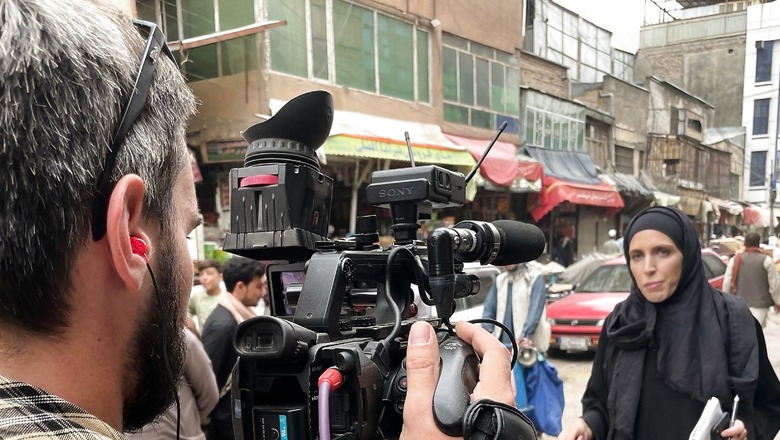
views
Exactly a week ago, a female presenter from TOLO News, Beheshta Arghand, interviewed Taliban spokesperson Mawlawi Abdulhaq Hemad, which was hailed as the first interview ever of its kind. This flash on TV was believed to be a vital step in establishing an international image different from the time they had ruled earlier.
Taliban 1.0 had seen the banning of Internet and television considering it to be highly immoral and anti-religious but since now Taliban itself is using technology to communicate and “create” content to spread through social media for its global audience, like videos of girls going to schools and “peaceful” protests by women in the capital, it has learnt to use it to its advantage and pass it off as a leniency to project itself as modern and a better version called Taliban 2.0. It also suits their mixed bag of fighters ranging from versatile media-savvy leaders to a relatively common gun-yielding on ground lot.
Considering how almost half of Afghan population is under 20 years of age and the average age in Afghanistan is 18 years, who have not seen Taliban rule before, social media relaxation is adding to their acceptance. But at the same time, videos of atrocities are coming out every day, and so are videos of resistance. Between all this, Ahmed Shah Massoud’s son, Ahmed Massoud, leading the National Resistance Front recently warned about the breakout of a civil war if discussions on power sharing were not held soon.
Uncertainty looms amidst hasty evacuations and airport havoc, amidst kids being ferried to “hopeful” safety to doctors falling off from evacuation planes, journalists are trying their best to flee to safety along with their families.
The regression of press freedom marked by hit list threats and restricted flow of truth with data that backs misery is certainly pushing all news organisations to evacuate their reporters to nearby countries or even back home. Over 70 media professionals and human rights activists have died between January 2018 and February 2021 alone. And the numbers certainly are much higher today.
Danish Siddiqui’s brutal death from multiple gunshots this year and the death of a relative of a journalist from DW last week show how Taliban’s second version is nothing but a communication backed potent weapon.
Julie Billaud, Professor of Anthropology at the Graduate Institute of International and Development Studies in Geneva and author of Kabul Carnival tells News18, “Afghan journalists are likely to be targeted. I heard reports of their houses being marked and Talibans searching house to house for them, as well as human rights defenders and other persons who have worked for the previous governments.”
There are hundreds of other stories of press reporters being harassed and beaten up for trying to report the truth, like for example Clarissa Ward, a CNN reporter, who’s reporting and presence from within the country was hailed as heroic considering what the Taliban have been like towards the women in the past, also left two days ago. Her producer faced a tense encounter with a Taliban fighter last week along when he was pistol whipped.
Kanika Gupta, a journalist who was in Afghanistan for two months, took the Globemaster that airlifted her and many others as part of India’s evacuation process last week. She says that, “as soon as people heard on radio that Kabul city had been compromised, people who could, rushed towards the airport in panic, did.”
Aditya Raj Kaul, Contributing Editor to the News18 Group says, “Afghan journalists are facing threatened in the wake of forced Taliban takeover in Kabul. Most of these local journalists have worked with foreign media organisations, which make them a direct target of Taliban and Haqqani Network. Taliban has already started preparing lists of journalists and silencing the state media as per their ideology. Several female anchors have been asked to step down as Taliban believes that women need to be in a Burqa or a Niqab and cannot study or work side by side with men. Young Afghans who have grown in Kabul over last two decades would find it suffocating and impossible to survive under Taliban rule and hence are trying to escape the nightmare.”
Rohan Dua, Journalist, explains, “During the last two decades following the Taliban’s fall, Afghanistan went on to build a robust media industry with even women journalists fearlessly reporting with bold opinions. But when Zainab Azizi — a leading TV journalist who worked with several international media outlets — went on to express lack of trust over Taliban’s commitment for free media, it only means future of media is uncertain. With CNN, CBS & WaPo having taken off their journalists from Afghanistan rosters, it is also unlikely that there will be a review of policy in such circumstances. Taliban’s public commitment to TOLO news also doesn’t inspire any confidence with such evidences in front of us where the US-based media organisations too have blamed Biden administration for being so non-committal.”
With the gradual withdrawal by leading media houses and with time, it will be clear how far will the freedom of reporting goes, how real it will stay and how Taliban will get to utilise the potential of social media to its advantage or collapse with the power of truth, the power of resistance, the power of will.
Read all the Latest News, Breaking News and Assembly Elections Live Updates here.

















Comments
0 comment